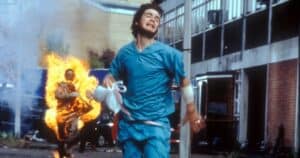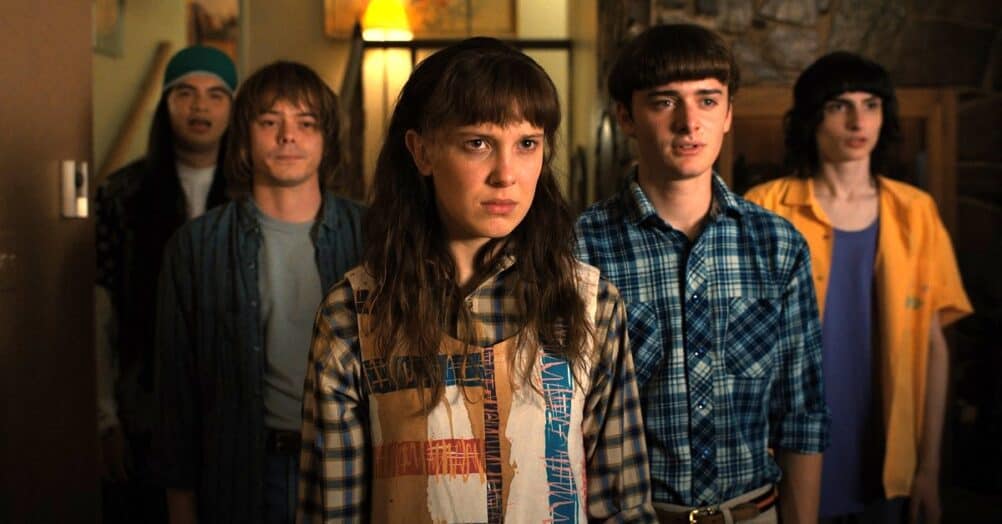Last Updated on July 30, 2021

We all have certain movies we love. Movies we respect without question because of either tradition, childhood love, or because they’ve always been classics. However, as time keeps ticking, do those classics still hold up? Do they remain must see? So…the point of this column is to determine how a film holds up for a modern horror audience, to see if it stands the Test of Time.

DIRECTED BY STEPHEN HOPKINS
STARRING ROBERT ENGLUND, LISA WILCOX, DANNY HASSEL, KELLY JO MINTER, ERIKA ANDERSON
Say, what’s your favorite A NIGHTMARE ON ELM STREET sequel?
Better yet, as far as pure premises are concerned, outside of the unparalleled original that is, what is your favorite A NIGHTMARE ON ELM STEET plot-line? Are your answers to both questions one and the same?
Not for me. While I’ll always go to bat for DREAM WARRIORS as my favorite ELM STREET sequel, there’s no way in flame-licking hell that I’d opt for its premise over the unthinkably sinister fifth franchise entry, THE DREAM CHILD. Seriously, a char-faced pedophile stalking you in your dreams with a razor-claw is one thing, but to have said monster lurk through subconscious dreams of your unborn child? Yeah, FUCK THAT! In any event, it’s hard to fathom that A NIGHTMARE ON ELM STREET: THE DREAM CHILD opened in theaters on August 11, 1989, marking this week as the 30th anniversary of the film’s release. What’s even harder to grasp is the fact the film was so rushed by New Line, that Aussie director Stephen Hopkins was only given four weeks to finish principal photography and only an additional four weeks to edit the film, in order to meet the theatrical release date set less than one year after its predecessor, THE DREAM MASTER (August 19th, 1988 to August 11th, 1989). Sheer insanity! Honestly, it’s a f*cking miracle the movie was at all watchable given such a venally speedy production slate, and even more miraculous if any of its pell-mell production can hold up 30 years later. But we shall see. You know the deal: it’s THE DREAM CHILD vs. The Test of Time below!

THE STORY: Let’s get this out upfront. Reportedly, Stephen King and Frank Miller were initially approached to write and direct THE DREAM CHILD, which they both roundly rejected. To think what King could have done with one of the most formidable modern-day boogeymen at the time would have been too damn intriguing to pass up. And frankly, had King’s regal namesake been attached to the property, perhaps THE DREAM CHILD would not have registered as the lowest grossing ELM STREET sequel of all time (it opened with roughly $8 million at the box-office, but still earned roughly $22 million domestically against a $6 million budget). As for the disturbingly distasteful plot, it actually came from a woman who recently bore her own child. New Line EP Sara Risher, who actually pitched the same premise for DREAM WARRIORS, one about Freddy stalking an unborn child, doing so to a pregnant producer in the room, who in turn became so upset about the idea that it was dismissed on the spot. However, when it came time to producer DREAM CHILD, Risher received a call asking “do you remember when you wanted Freddy to have a baby? We like the idea now!”
The idea was incorporated into the character of Alice, who survived events of THE DREAM MASTER. As she graduates school and begins summer vacation, her twisted nightmares populated by Freddy Krueger resume once again. Only this time, even before she gets pregnant, Freddy uses Alice’s dreams to pull her friends in and murder them in front of her. Alice’s dopey teenage friends include Yvonne (Kelly Jo Minter), Greta (Erika Andersn), Mark (Joe Seely), and boyfriend Dan (Danny Hassel). Alice is also wracked by visions of a mysterious nun consigned to an insane asylum, who bears the name Amanda Krueger (Beatrice Boepple). Amanda births an odiously deformed little grommet that skitters across the hospital floor, which surreally morphs into the church where Alice defeated Freddy in DREAM MASTER. The baleful baby locates Freddy’s remains, consumes them and soon sprouts into an adult version of Krueger, now empowered to resume his somnolent reign of slaughter. And of course, if that wasn’t alarming enough, soon Freddy attempts to use the body of Dan and Alice’s baby, Jacob (Whit Hertford), to reenter the real world and transcend his murderous dream state.

WHAT HOLDS-UP: Whether intentional or accidental, one of the things that really work in the favor of most ELM STREET films, and DREAM CHILD in specific, is how the story-lines sacrifice cogency for certain level of chaotic, soporific surrealism. The film does not adhere to the logic of the real world, but to dream logic, which does not hew to the linear time frames of cause and effect, or of a beginning, middle and ending. The subtle and seamless ways in which Hopkins slides from the real world, which has a certain order, to the dream realm, which defies even the laws of gravity at times (the finale, for example), is hard to describe much less quantify, but really is one of the pillared foundations of why the movie works as well as it still does today. Sure parts of the movie come off confusing, but the incoherence is worth the fluid, otherworldly depiction of nightmarish dreamscapes.
Another thing that bolsters the film as well today is the vivid production design, sickening set decorations and menacing mise-en-scene of the entire movie. It starts with the dark, dank and dingy mental asylum where Alice spots Amanda for the first time. The lashing thunder and whipping lightning through the barred-arched windows, the shadowy corridors and blood-red walls, the dirty leaf-strewn floors; they all coalesce to create a nightmarish environment that feels just as unsettling as it must have in 1989. Same goes for the aforesaid church location, with its ornate stained-glass windows, moldering pews, filthy ghostlike drapery hanging from the ceilings, wax-melted torches, etc. Word is Hopkins, in order to meet the rushed production schedule, had to build each set in advance of the one he happened to be shooting on, so that he’d be ready to film any scene at any given time.

One more prime example of the sturdy set designs is the comic book shop that Mark hangs out in. It’s full of cool props and decorations that prove to be vitally germane to his death later in the film. The dinner table scene where Greta meets her murderous maker is eerily gothic and surreally unnerving as well, almost as if it were out of a goddamn Tim Burton movie. It was a wise decision by Hopkins and New Line to bring back production designer C.J Strawn, whose intimate knowledge working on DREAM MASTER carried over to an equally eldritch design.
As far as the gruesome violence and concomitant practical FX work is concerned in the film, there are at least two specific sequences that really rival anything released in the horror industry today. The first is Dan’s imaginative cyberpunk demise. Damn does this f*cker get it good! Once Alice finds out she’s pregnant with Dan’s baby, she tries to contact him as he peels out on a motorcycle at nighttime. Problem is, once Danny boy falls asleep, he’s methodically murdered by Krueger in one of the most inventive ways of the entire franchise. First, Freddy accelerates Dan’s bike to warp-speed. Then the mechanical cables from the motorcycle begin to protrude, almost as if fleshy umbilical appendages, into his hands as they crutch the handlebars. Undone, the coils begin jutting in and out of his arms, legs, face and mouth while Freddy stabs him a few times with the glove. Dan is electrocuted before morphing into a skinless cyberpunk skeleton before his fiery bike his flown headlong into oncoming traffic. Talk about ghost riding the motherf*cking whip!

Where the violence and practical FX come together in the most durable way is in the final 15 minutes of the film. We see baby-Freddy’s fluidity and dexterity early on in the film, which is still pretty gnarly, but here is where the impressive designs of KNB FX are on full display. Not only when adult Freddy’s head conjoins with another character in a gooey flesh-melted manner, but also in the way in which Freddy sustains his own punishment. When Alice drives a sharpened pool skimmer through his mouth and the giant wheelchair-claw through his spine, the FX still look pretty damn legit. So too do the composite shots and mattes of the gravity defying sets, INCEPTION style, where there’s a vertiginous difficulty in grasping where each character is physically located. It’s all meant to jar and disorient the viewer, and it still does a good job of doing that without feeling too passé. The animation on the other hand? Whew, that’s another tale altogether!
WHAT BLOWS NOW: To be real, there are more irksome aspects of THE DREAM CHILD than I anticipated. The first is the excised 2-minutes of extended grue and graphic violence that was spared in order to avoid an X-rating. F*ck that. I mean, it must have sucked in 1989 too, but given how far the limits of onscreen carnage have come in the subsequent 30 years, the uncut footage is relatively tame by comparison. Worse, said footage was restored on the unrated VHS but never on the DVD. WTF?!

Also, not for nothing, but Krueger tallies a pretty paltry body count in THE DREAM CHILD. Granted, the sheer premise is enough to induce emesis, so we probably didn’t need an extra dozen corpses to go along with it. But still, what’s Freddy kill, four or five people in the film? Not good enough. Not for an A-list hall of fame horror villain like the Krueg. Hell no. And speaking of substandard, Freddy’s limp and unfunny one-liners really begin running their course in this film. His humor used to be mordant and caustic, but by now it’s just sort of lame and unimaginative, going well beyond camp into borderline parody. Seriously? “Kids…always a disappointment.” “Put the pedal to the metal, Dan!” “This boy has a need for speed.” Whack. Whack. And whack. It’s much better when he spouts “Bon Apetit Bitch!” to Greta before turning her into Audrey from ERUOPEAN VACATION.
The absolute worst part about THE DREAM CHILD now is its painfully dated cut-rate animation. Holy hell, I’ve seen better graphics on Atari! The animates shots of baby-Freddy are embarrassingly bad, as is the quick shot of animated tarantulas in the third act. But where the animation really suffers is in the cartoonish demise of Mark, the comic book nerd who literally gets turned into a page from one of his comics before being shredded to death by Freddy. For a movie shot and completed in a shocking two months, you can tell there was simply not enough time or money allocated to the animated sequences in the film. As a result, they almost threaten to turn an otherwise entertaining horror sequel into an watchable piece of pabulum. Almost!

THE VERDICT: All things considered, A NIGHTMARE ON ELM STREET: THE DREAM CHILD holds up pretty well, but it’s not perfectly untainted. The premise holds serve, as does the sheer surrealism and dizzying dream logic. The piercing practical FX and detailed set pieces still convince by today’s markers, as does Dan’s grisly death sequence. However, the chintzy animation, lack of gore and low body count and neutered sense of humor do sort of issue the film an impending expiration date. THE DREAM CHILD is defeating the Test of Time at 30, but what about 60?


















Follow the JOBLO MOVIE NETWORK
Follow us on YOUTUBE
Follow ARROW IN THE HEAD
Follow AITH on YOUTUBE